#actionplan, #sustainability
2018 Sustainability Action Plan

Urgent action by our profession is needed to address pressing environmental and health issues including climate change. LMN’s commitment to address these challenges is one of our core values; embracing sustainable design is fundamental to the work we do.
Download the LMN 2018 Sustainability Action Plan PDF
We believe
- Design has the power to transform our interactions and foster healthy, livable communities and an equitable society.
- Humane and inviting urban spaces help to preserve wild and natural areas.
- Research and innovation is integral to the practice of architecture.
We actively
- Help our clients realize their sustainability aspirations through a holistic, collaborative design process.
- Combine the hard data of performance modeling with the inspirational qualities that improve human health.
- Advocate for policies that align with our values including reduced carbon emissions and water use, materials transparency, equity and resilience.
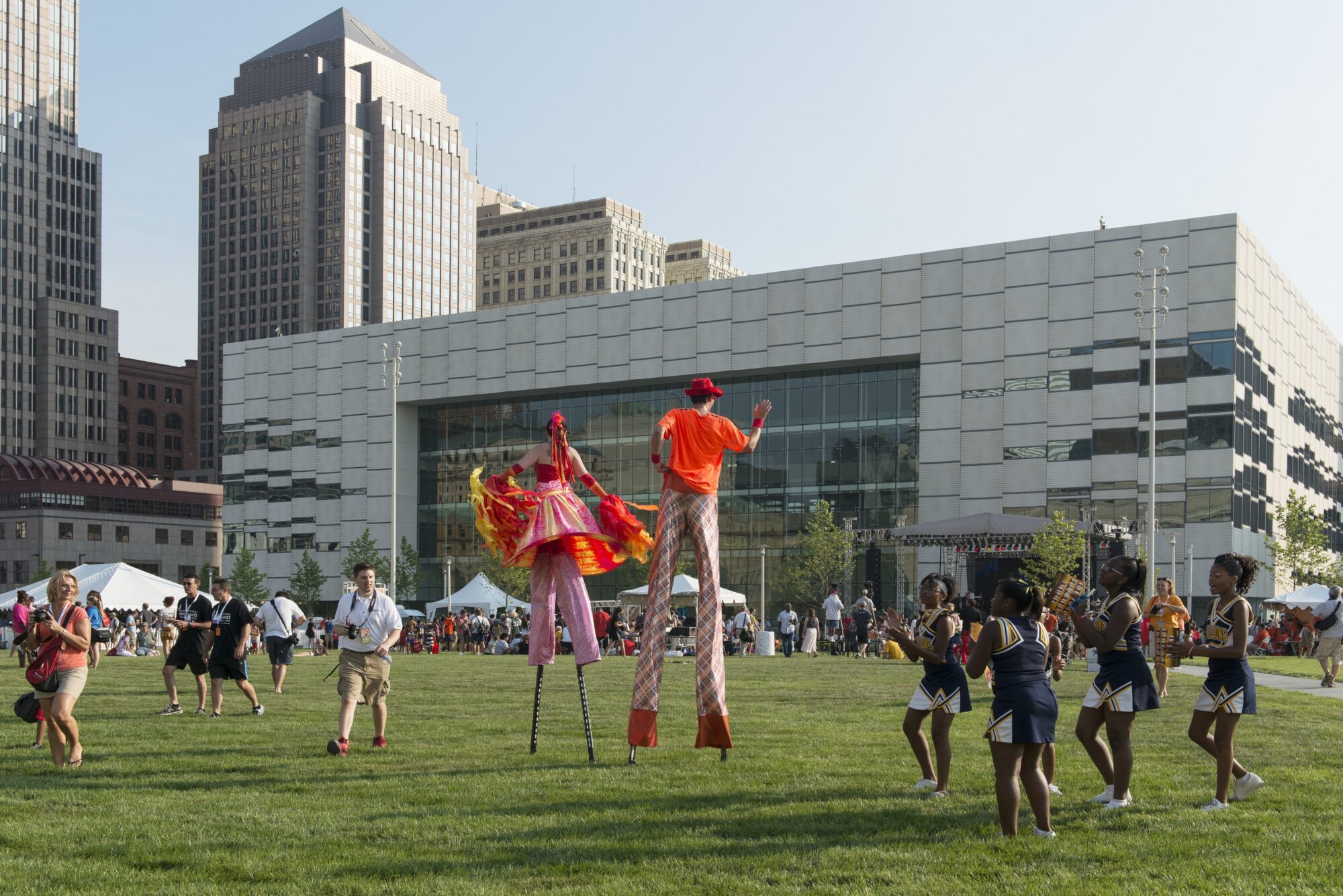
LMN’s Cleveland Convention Center is mostly underground, creating a full-block park at street level.
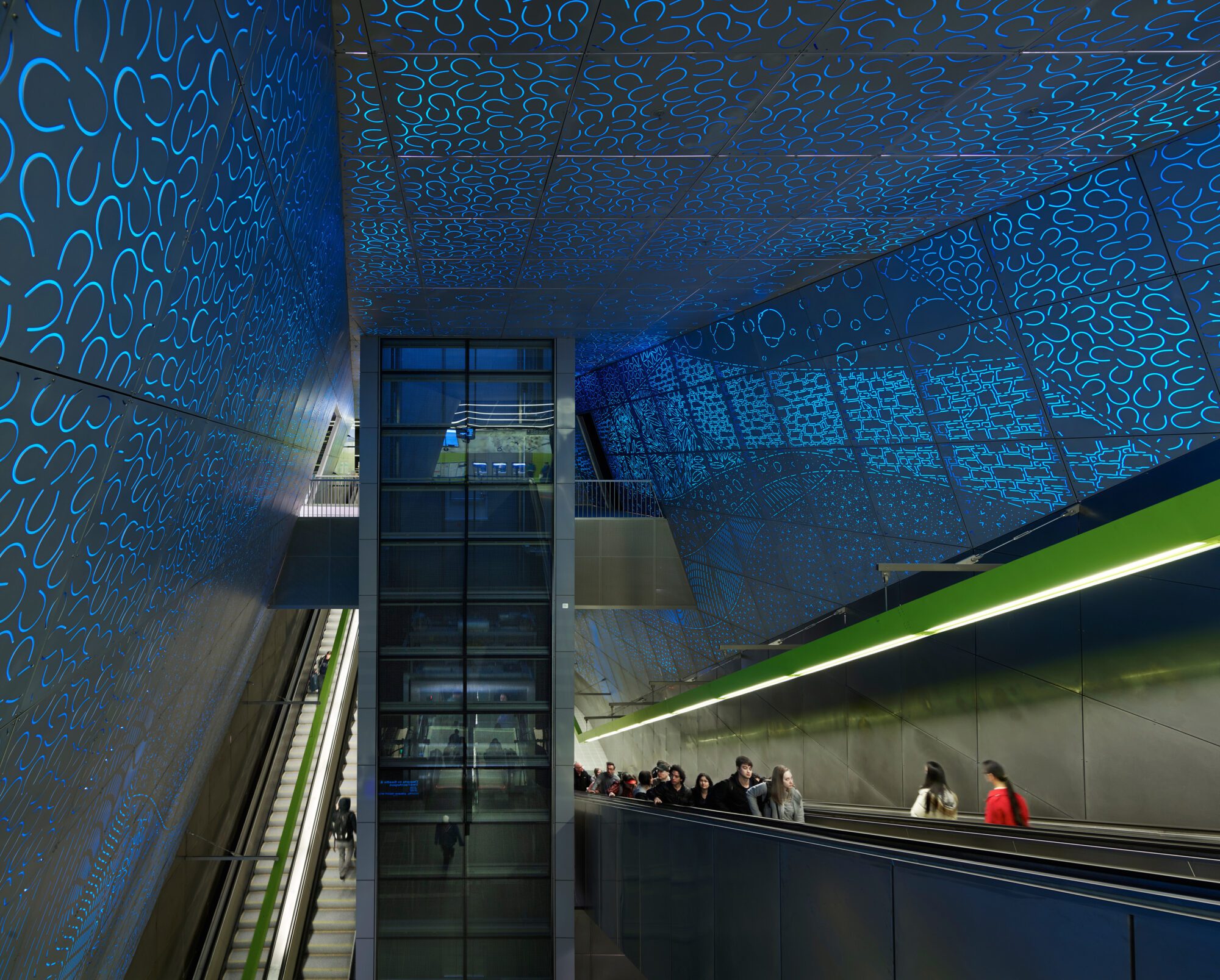
LMN Architects and artist Leo Saul Berk collaborated to create an integrated experience for travelers at the UW Light Rail Station, winning 10 regional and national design awards. As part of our urban commitment, LMN has designed 10 light rail stations in our region and is now planning for 7 more as part of the West Seattle and Ballard Link Extension.
Highlights
This 2018 revision to our Sustainable Action Plan provides an opportunity for self-reflection on areas where we are succeeding as well as striving to improve as a practice. Some highlights from our progress:
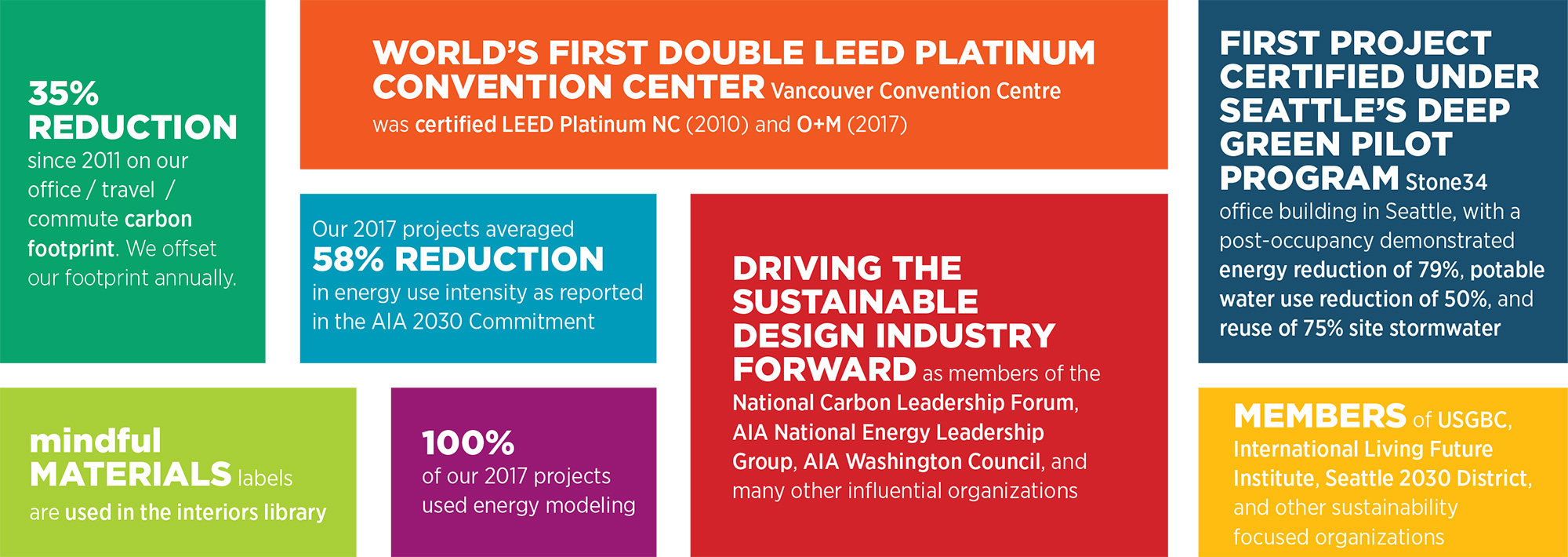
Firm Commitments
IMPROVING THE URBAN COMMONS
As the world’s population migrates toward urban areas, architecture—with its power to catalyze urban vitality and enrich public life—has never been so important. Through more than 150 civic, cultural, institutional, and mixed-use projects in 80 North American cities, we have embraced this responsibility by designing projects that engage the diverse patterns of community life, sharpen civic identity and promote sustainable urbanization. Invigorating urban environments draw people into the city, preserving wild and natural areas and reducing our combined environmental footprint.
While all our projects are crafted to enhance the urban experience, we have taken on projects beyond the building scale, infusing urban infrastructure with quality design. This includes design oversight for the light rail lines and many of the light rail stations in our region – such as the award-winning University District Station, designing a landbridge over the 520 freeway to stitch neighborhoods together, and several pedestrian bridges to promote walking, running, and biking.
We collaborate with our peers, elected officials, and the public to re imagine our cities for the 21st century. This includes our 15-year involvement in re-imagining Seattle’s waterfront as leaders in Friends of the Waterfront Seattle and AIA’s Waterfront Task Force, engaged membership in AIA Seattle’s Public Policy Board, continual leadership as board members of Design in Public, and overall organization as well as annual pavilion design and construction as part of DIP’s Seattle Design Festival that includes regular attendance of over 30,000.
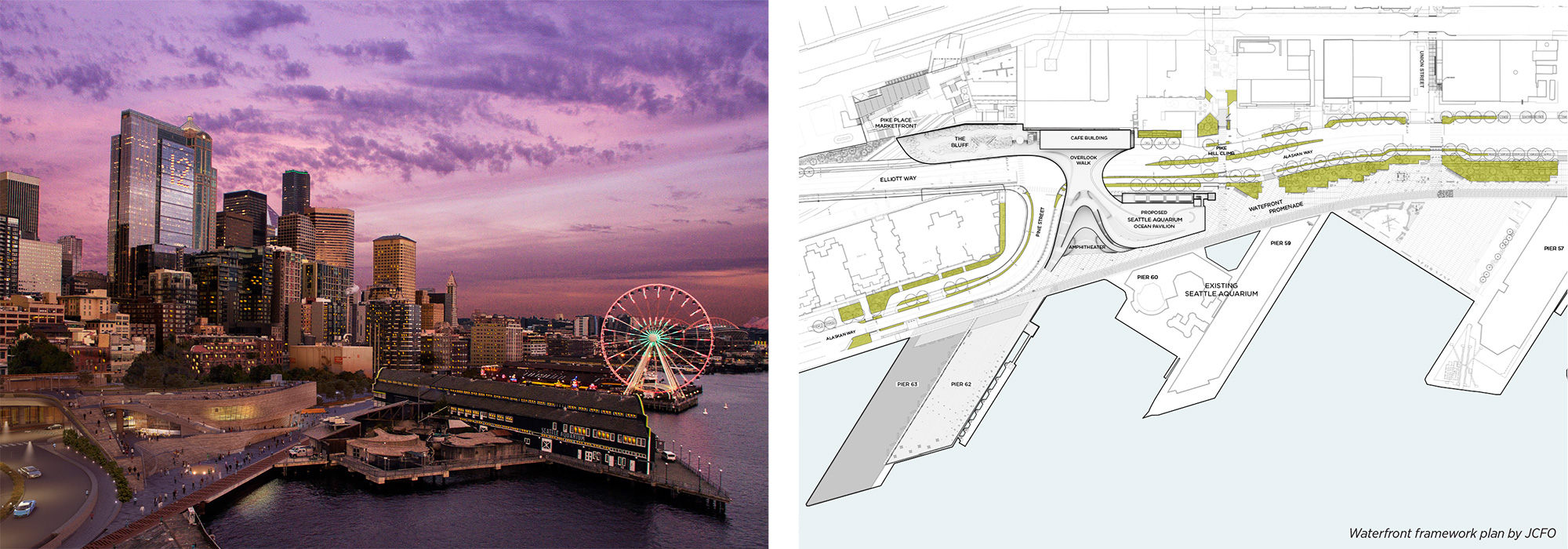
Waterfront Redevelopment Seattle, WA - LMN has been instrumental in guiding the Waterfront re-imagining efforts to make our city more livable and equitable, re-establishing our historic connection to the Salish Sea. Since 2002, LMN has volunteered countless hours to this effort, serving on the Waterfront Oversight Committee, the Seattle Design Commission, and Friends of the Waterfront to help shape our city and advocate for a Waterfront for All.
ENERGY + CLIMATE CHANGE
Climate Change continues to be one of the defining issues of our time, with our buildings sector responsible for between 40% and 50% of CO2e emissions. The projects that we complete design for in a given year will, as a group, contribute around 10,000 MT CO2e for each year of their operation.
LMN has committed to address climate change in our internal operations, through advocacy, and most importantly through our design of buildings.
We operate as a carbon neutral company by assessing our carbon footprint and purchasing offsets each year.
We are also active in many advocacy issues, including development of energy codes at the local, state and national levels; through helping craft and promote a state carbon tax, and as co-authors of AIA’s first position statement on Climate Change.
For projects being designed in 2017, we averaged 58% energy savings across our portfolio and reported this as part of the 2030 Commitment. Although most of these energy savings are due to increasingly stringent energy codes, we frequently are able to push our projects beyond code and client expectations – within budget – by using energy modeling as a design tool. In 2017 we averaged 22% beyond code across our portfolio.
We are completing design on our first commercial-scale Mass Timber projects and educating ourselves and our clients on the use of wood as a carbon sequestration technology.
CARBON NEUTRALITY AS A NEAR-TERM GOAL
We are a 2030 Commitment signatory, which includes tracking and reporting the predicted energy use of all projects each year. The 2030 Challenge suggests an 80% reduction in building energy use with an additional 20% made up with renewables by 2030. When our clients demand energy efficiency we are able to deliver, and many of our leading projects are nearing the 80% threshold. However, we can do more with the projects where there is no stated energy goal.
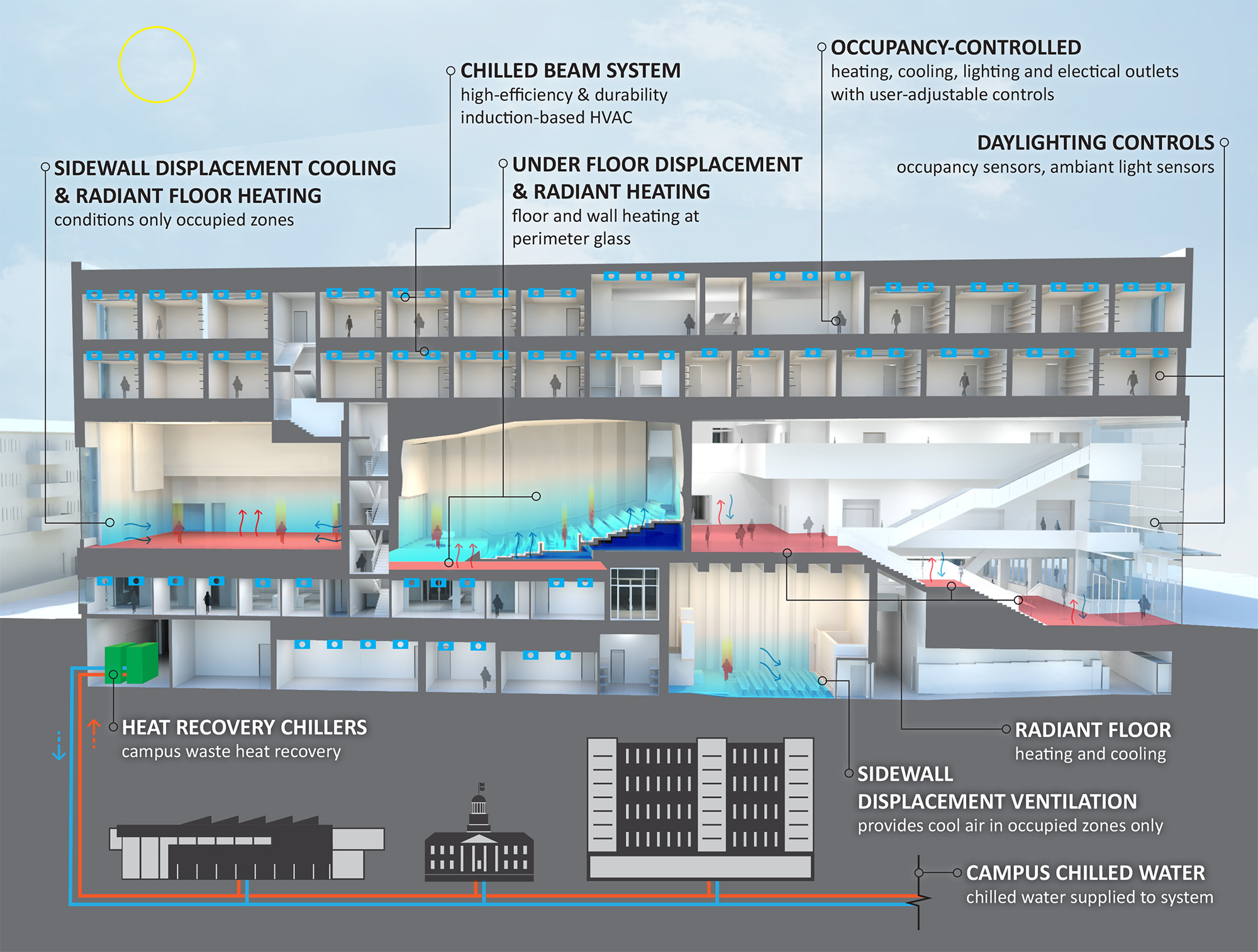
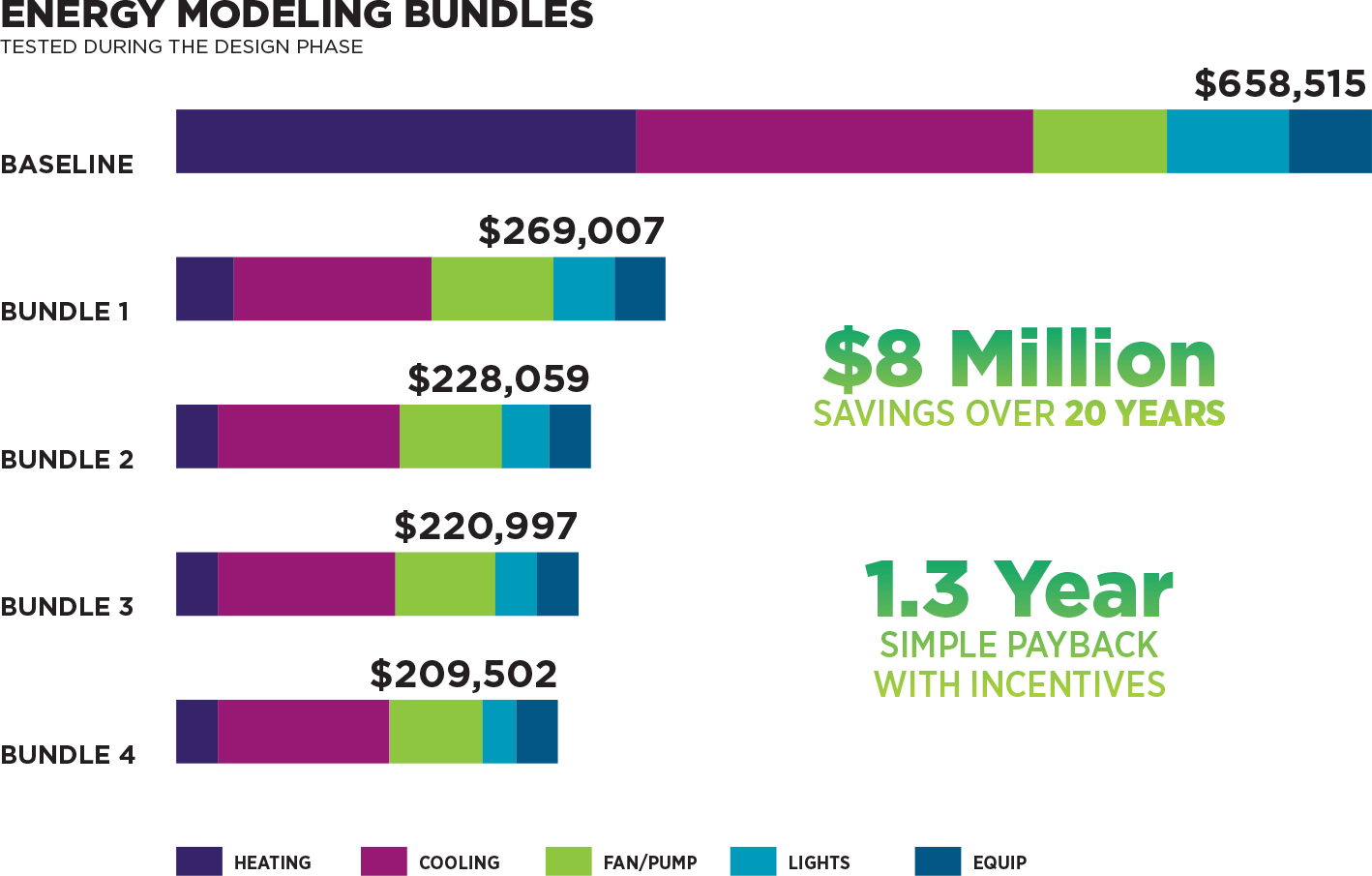
Voxman School of Music Iowa City, Iowa - Energy modeling was used to inform decisions that led to significant energy and cost savings.
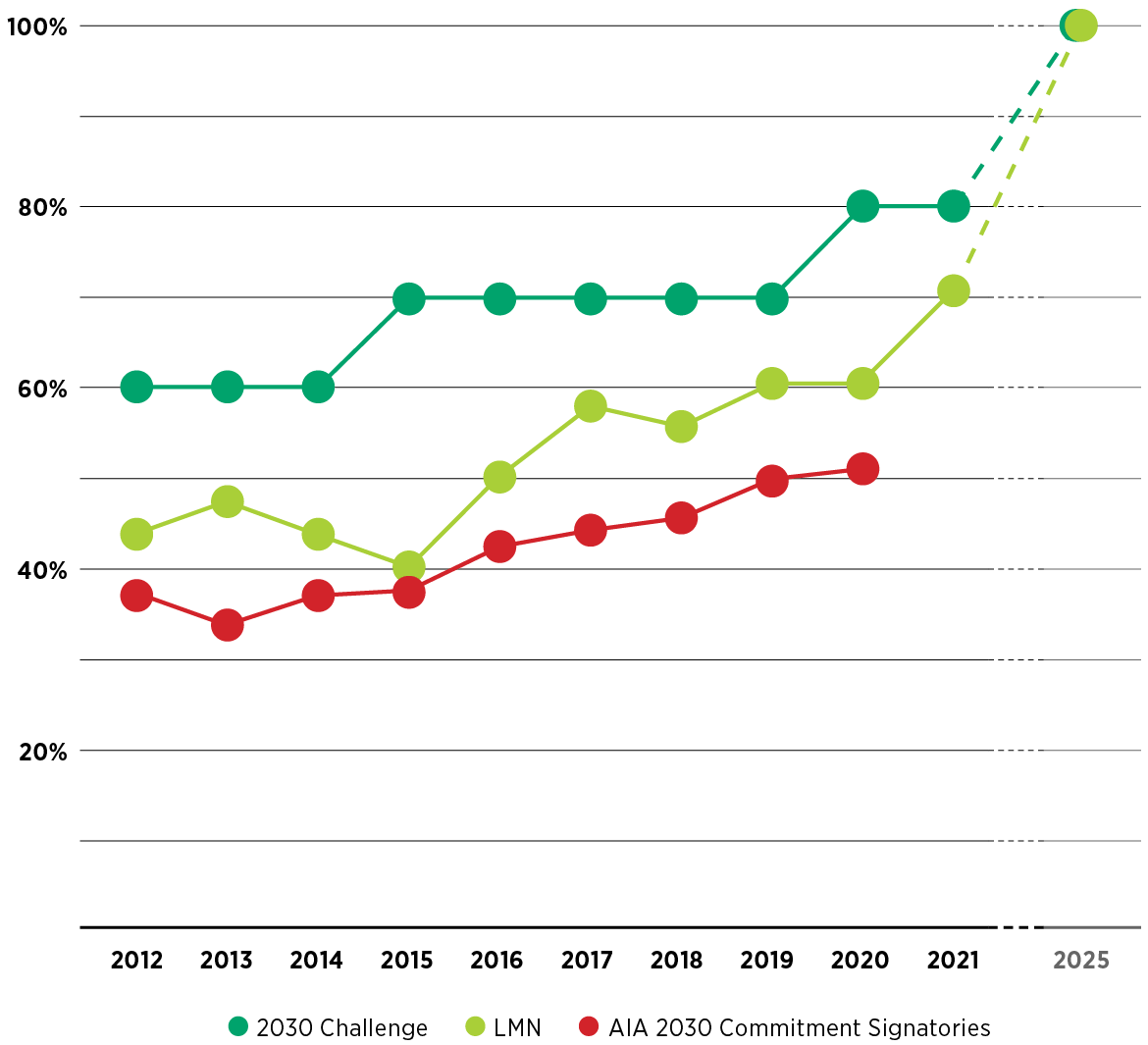
2030 Commitment Energy Tracking - LMN's Progress Towards Net-Zero Energy Buildings
ON EVERY PROJECT, WE COMMIT TO
- Assign a Project Sustainability Coordinator, supported by a Full-time Director of Sustainable Design
- Set reasonable, quantifiable energy or carbon goals with each client
- Focus on early design decisions and passive design measures to reduce loads
- Engage with early energy assistance and modeling
- Ramp up in-house early energy modeling skills and use
- Use envelope consultants to assist in reducing infiltration energy losses
- Reduce potable water use to eliminate energy used for water treatment and distribution
- Endeavor to work with clients that align with our principles and have net-zero energy, water, and other high performance design goals, including providing a path to carbon neutrality
STRETCH GOALS FOR THE NEXT 5 YEARS
- Improve the energy performance of all projects for an average of 80% energy and Co2e reduction, in line with 2030 Challenge performance goals
- Design of at least one Net-Zero energy or carbon project
- Focus on CO2e reductions instead of just energy reductions
- Advance our use of embodied energy modeling to reduce the carbon intensity of building assemblies
- Increase our use of post occupancy energy assessments to inform our design decisions
Additional carbon-related efforts are under Advocacy + Outreach and Operations + Maintenance.

Energy Savings - LMN often goes beyond client and code energy requirements. Reductions are in reference to 2003 CBECS survey or equivalent.
Water
Fresh, clean water is a prerequisite for life. While only 10%-15% of fresh water consumed in the US is used in and around buildings, this requires around 75 billion kWh each year, or about 2% of the annual US electricity consumption for treatment and pumping. In addition to energy goals that reduce water used for power generation, LMN has committed to analyzing and advocating for using and re-using water wisely on our projects. We also advocate for improvement in the quality of water that leaves the site; the compounds suspended in it are a large source of pollution in our Salish Sea and other water bodies.
This is especially important for our Seattle Aquarium expansion with their focus on ocean health, including protecting our watersheds and local water bodies. When completed, the Seattle Aquarium Expansion will reach over 1.2M people annually through events, attendance, and outreach.
Understanding the full cycle and re-use potential led us to visit several of our built rainwater and graywater reuse systems in 2017, including Vashon Center for the Arts, Brooks Sports, Seattle Central Library, and the Vancouver Convention Center. We also reviewed other projects where water re-use was studied.
Vashon Center for the Arts was designed to use no potable water for toilet flushing during the average year. Climate change has altered precipitation patterns, so less water can be captured during the summer to fill the cistern; for 1-2 months a year potable water is used.
The Seattle Central Library rainwater cistern, after 13 years of operation, works spectacularly. We checked in with the Facilities staff and the system requires nearly no maintenance. The plants have thrived on cistern water, with no potable water use since plant establishment.
ON EVERY PROJECT, WE COMMIT TO
- Analyze water capture and reuse flows and strategies
- Use 1.1 gpf or dual flush toilets, .1 gpf urinals and other high performance fixtures, exceeding LEED prerequisite for potable water use reduction
- Communicate with our clients about xeriscaping and reducing or eliminating potable water use for landscape irrigation
- Look at Salmon Safe and similar regional criteria for storm water quality and quantity
STRETCH GOALS FOR THE NEXT 5 YEARS
- Design of at least one net-zero water facility
- Incorporate graywater and rainwater reuse on a majority of our projects
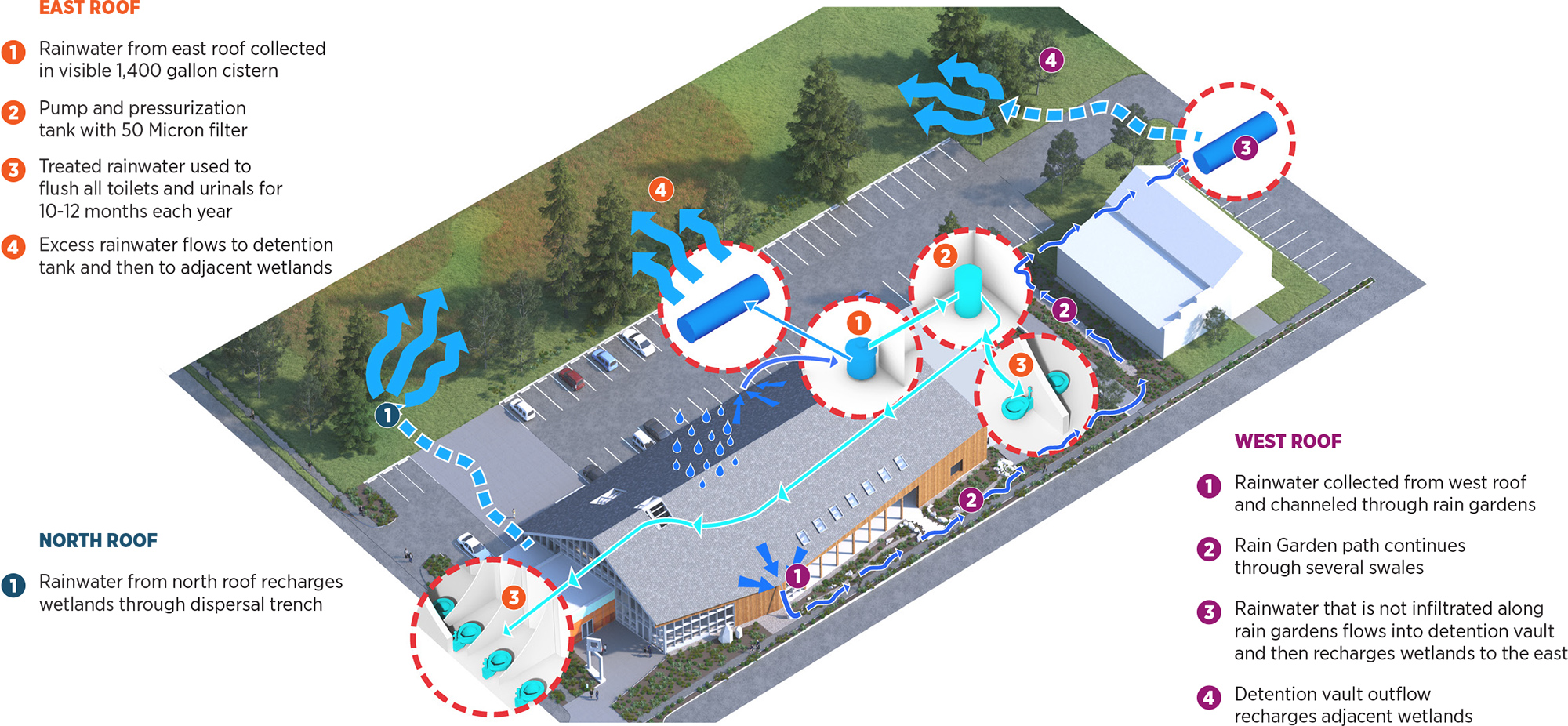
Water Diagram Vashon Island residents have an important understanding and connection to water since all drinking water sources, including the single-source aquifer, are supplied by precipitation.
Wellness
Wellness is an emerging field that includes how architecture can promote human health and mindfulness. Access to quality daylight and light, activity, air, and water has been shown to improve health and productivity, and are integral to good design. LMN’s wellness commitments go back decades, but we are striving to do more in emerging topics, especially materials and health.
We are leaders in Seattle’s Healthy Materials Collaborative (HMC), dedicated to increasing product ingredient disclosure at a city-wide scale. Our efforts at HMC include leading the design and construction of a public installation at Seattle’s Design Festival, organizing a Material Librarian Summit attended by over 50 people, and co-authoring a letter that many Seattle firms have signed that requires material transparency among product manufacturers and representatives.
To embody our commitment and refine our skills, LMN’s 2014 remodel of our office space vetted all new materials against the Living Building Challenge Red List. While not 100% Red List free – a few materials did not exist at that time in a Red List free form – the remodel allowed us to take major steps in greening our Specifications. The remodel also includes access to daylight and views for 100% of our staff. Discussion of other wellness aspects are covered later in Operations and Maintenance.
ON EVERY PROJECT, WE COMMIT TO
- Labeling of all interior materials in our Library using the Mindful Materials label
- Having conversations with clients about materials and health
- Eliminate the use of vinyl in our Specs, except where no alternatives exist or required by client
- Education and Leadership in AIA Materials Matter, the Healthy Materials Collaborative, and internal Spec Hackathons
- Communication of our Materials + Health goals to manufacturers
- Maximizing access to daylight for occupants
- Use of natural ventilation where appropriate. Natural ventilation can reduce energy use and connect occupants to the outdoor biome
STRETCH GOALS FOR THE NEXT 5 YEARS
- At least 20% of staff to be WELL accredited
- Reviewing + removing materials that are on the Red List or are suspected of reducing indoor air quality or adversely affecting those along the supply chain from our Materials Library and Specifications except where no alternative exists
- Increasing our vetting of FF&E for materials and health criteria
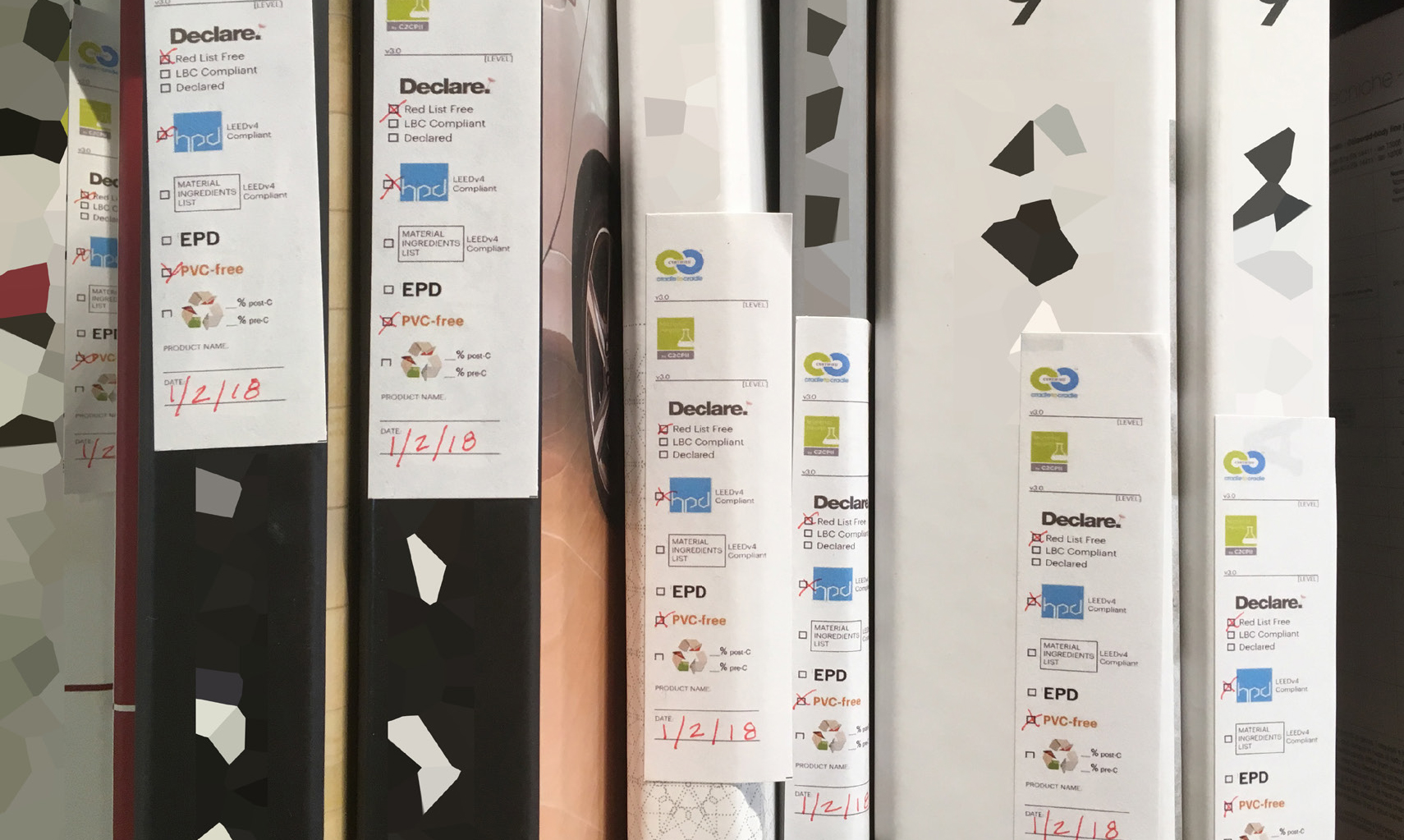
LMN’s Material Library uses the Mindful Materials label and contains no vinyl products
Design + Approach
Good design = sustainable design. We convene diverse expertise including staff, consultants, clients, and contractors to inform decision-making from project inception through occupancy. We look for whole-building and whole-site solutions to complex design challenges, merging thoughtful integration of sustainable design goals with site, building systems, structure, public enjoyment, and function.
Each project at LMN begins with an exploration of and commitment to relevant energy efficient and environmentally responsible design. We engage the entire team in an early and ongoing collaborative process, establish measurable sustainability goals at the outset of the project, utilize design studies and performance modeling tools and technologies to test ideas and evolve the design, and instill accountability throughout the implementation phases of the project. We engage in ongoing research and tracking of post-occupancy project performance to inform future design strategies.
TEAM COLLABORATION
- Engage the owner in meaningful, early goal setting, informed decision making, and allocating resources (cost, contract, and schedule) in support of team collaboration
- Facilitate a design charette near project outset to understand and document perspectives of key team members in an effort to maximize sustainable design solutions and cross-disciplinary problem solving within project constraints. Continually track progress against these early goals
- Assign a Project Sustainability Coordinator to support each project team and champion the sustainable design goals throughout the project. PSCs gather monthly to share innovative strategies and lessons learned. PSCs are required to have or pursue LEED or WELL accreditation
- Involve the Director of Sustainable Design in project pursuits and marketing efforts, as appropriate, to ensure we address client sustainability drivers at the earliest phases
GOAL SETTING
- Project teams assess the owner’s sustainability-related principles and objectives, documenting specific and measurable goals that align with LMN’s commitment to sustainable design.
- Project sustainability goals are communicated and tracked throughout the design process.
– Document project sustainability goals in the Owner’s Project Requirements
– Develop and review a Basis of Design that reflects project goals.
– Assist owners in choosing and pursuing Green Building certifications such as LEED, WELL, or the Living Building Challenge to track, verify, and reward implementation of sustainable design goals.
DESIGN STUDIES / EARLY ENERGY MODELING
- Project teams use quick design studies and early energy modeling and input to identify opportunities for synergies between disciplines, test ideas and influence the building form and mass, responding to current and future climate scenarios and site conditions.
- 100% of our major projects in 2017 used some form of energy modeling as part of the design process. We are continually striving to incorporate energy modeling earlier in the design process to inform our decisions.
- LMN Tech Studio teaches project teams to use conceptual modeling and simulation software to explore early design alternatives, including daylight and natural ventilation strategies. Tech Studio also assists project teams to interface effectively with more advanced energy modeling consultants.
IMPLEMENTATION AND ACCOUNTABILITY
- The project team continues to reference the sustainability goals throughout CDs and CA to accurately convey the intended sustainable design solutions. Internal QC review confirms strategies are incorporated into the construction documents.
- Employ life-cycle cost analysis to inform product and system selection
- Select materials utilizing LMN’s “green” specifications and vetted material library
- Sustainability Review as part of QA/QC phase reviews
- Staff onboarding includes familiarization of LMN’s sustainability commitments and resources
- Lessons Learned are covered in the next section – Evaluation + Reporting.
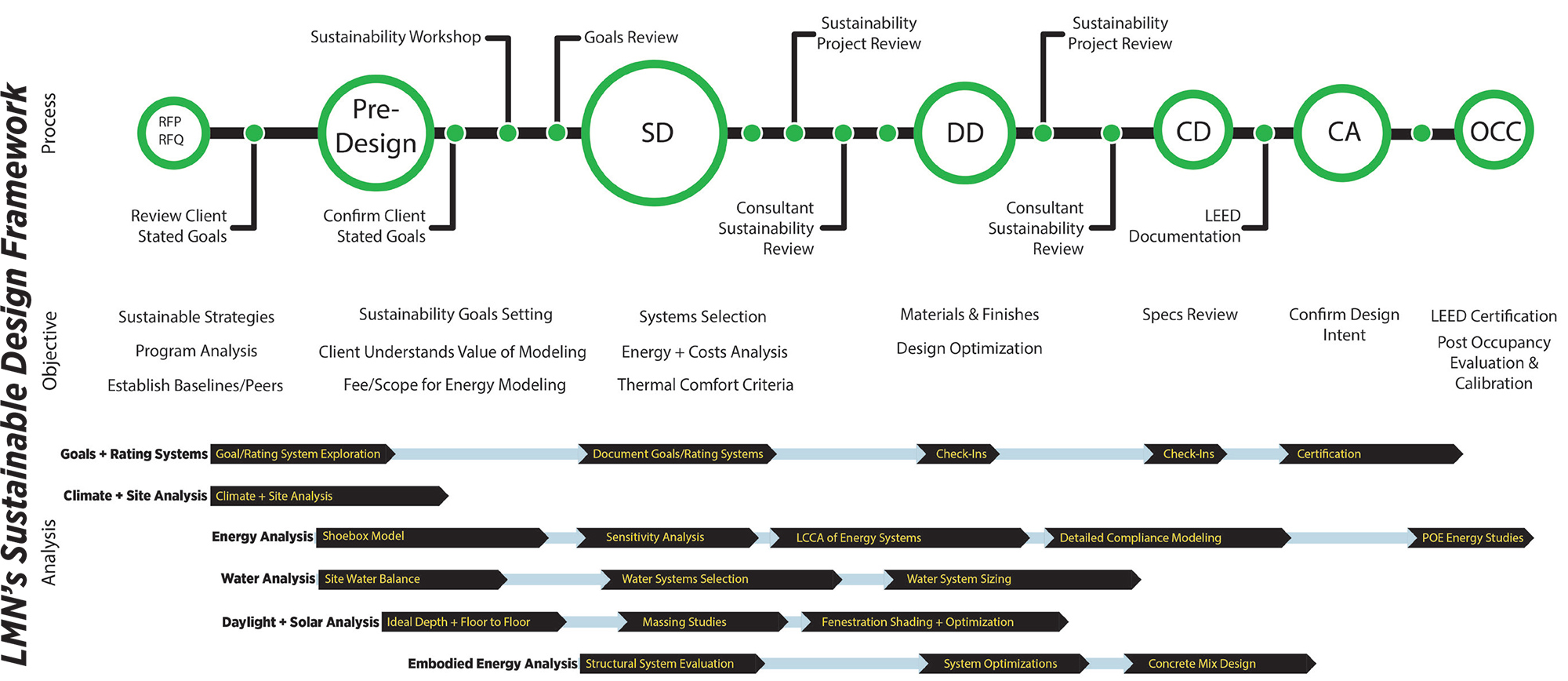
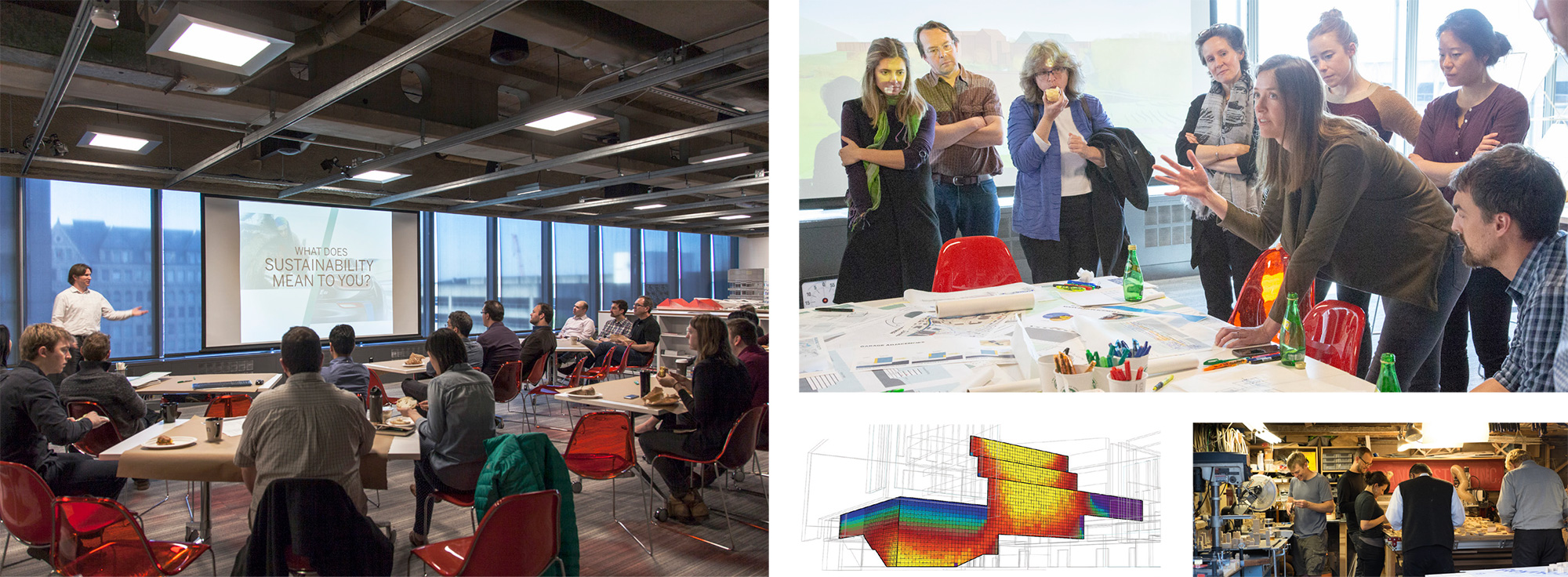

Conversations with our clients about thermal comfort have been important on LMN’s four recent naturally ventilated projects. The above graphic shows adaptive thermal comfort ranges during warm periods in the Seattle area.
Evaluation + Reporting
During design, we look for relevant energy use baselines and track progress towards our energy goals and other metrics as part of the AIA 2030 Commitment. Increasingly we use carbon emissions instead of energy use to track our progress towards the 2030 Challenge goals.
Beyond tracking design progress, reflecting back on our work after each milestone, including after the building is occupied, helps us improve our current and future designs.
STRATEGIES INCLUDE
- Check in after one year of occupancy with each client
- Facilitate transition from construction to occupancy, especially for unique systems and strategies including natural ventilation, atypical controls, and green education
- Compare actual reported energy use to predicted energy use for Seattle projects and those where we can get POE energy use data.
- Evaluate naturally ventilated spaces and help educate the building users and staff about proper use of the system
- Continue implementing rigorous post-occupancy studies on energy use, indoor temperature and air quality, and the use of planned social spaces to create a sense of community.
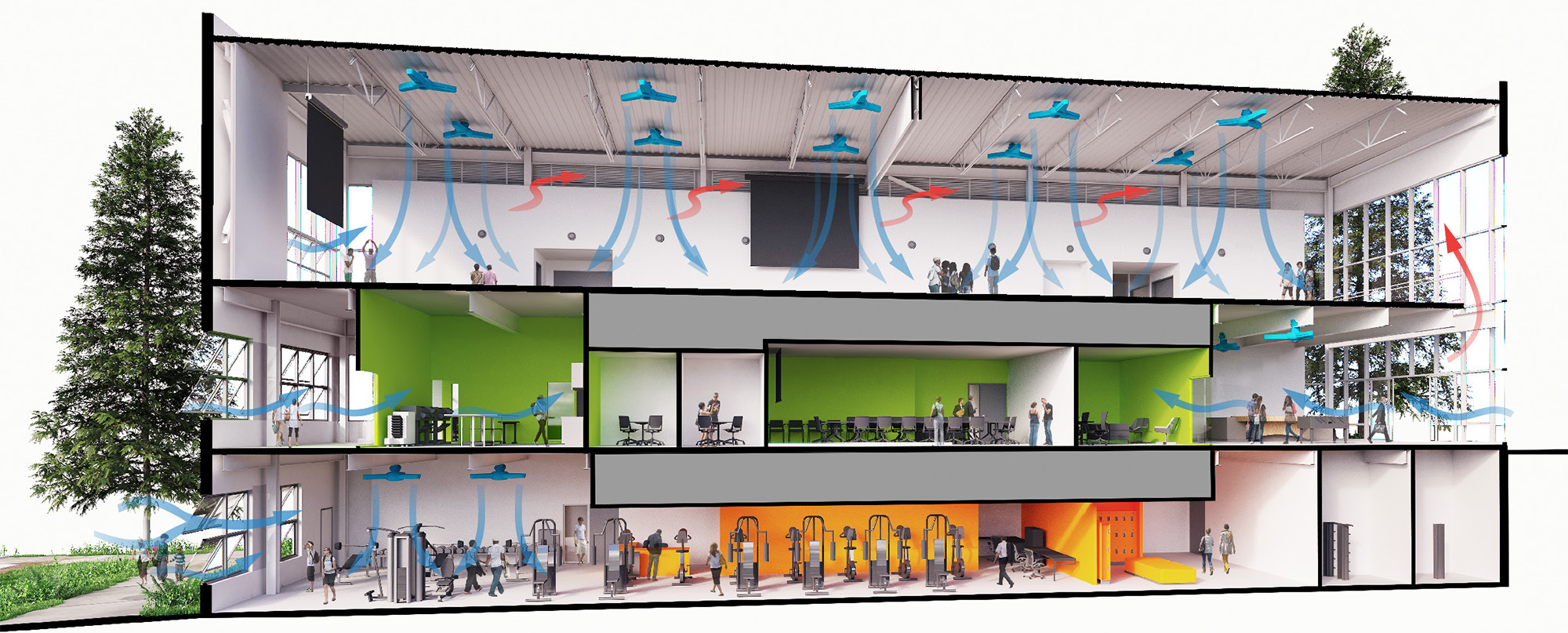
The UW Bothell Student Activity Center uses natural ventilation for fresh air and all cooling needs. Energy and ventilation modeling informed the facade design and massing throughout the design process. However, naturally ventilated buildings have a different standard of thermal comfort and are less well understood in how they perform. LMN is engaging in detailed comfort studies using hardware we developed in-house, the post-occupancy evaluation PODD.
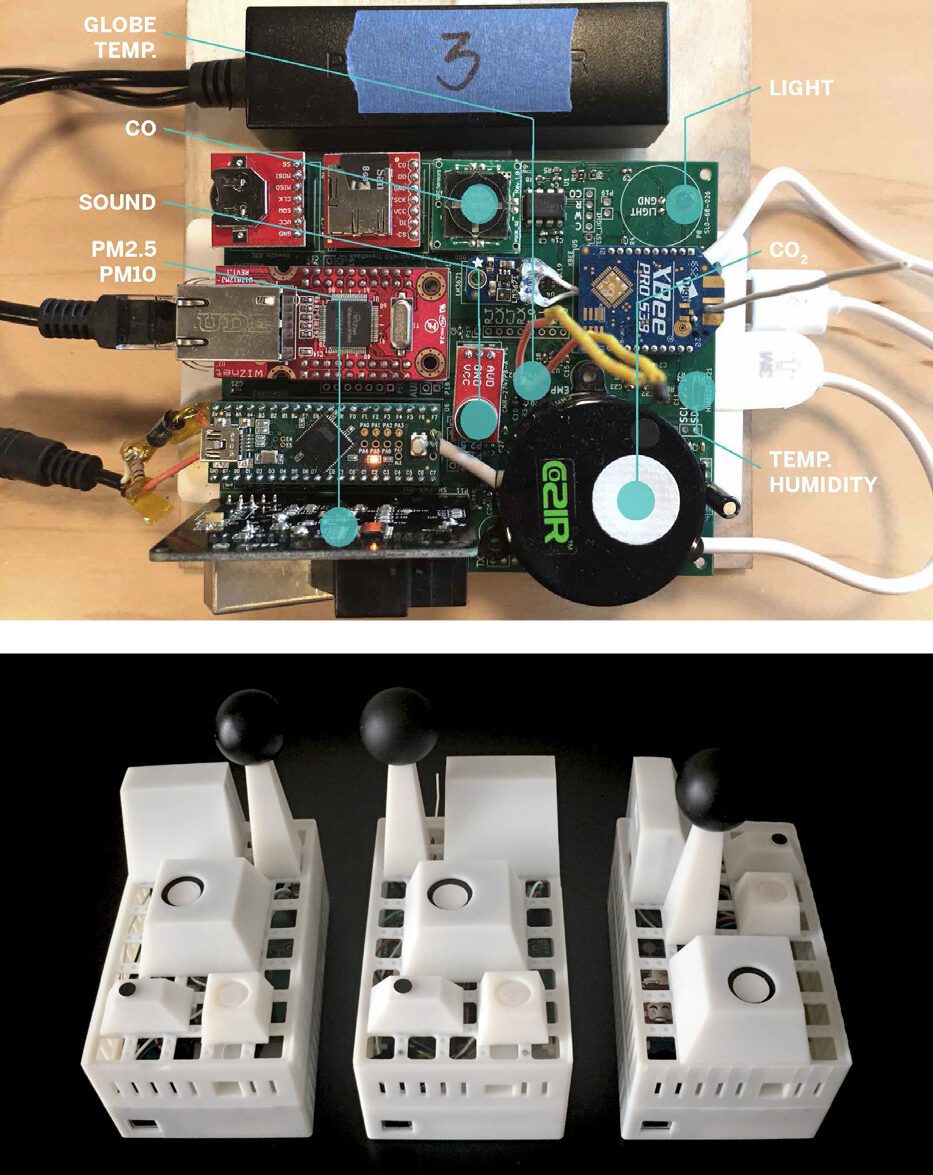
Current PODD prototype
POST-OCCUPANCY EVALUATION PODD
As part of our Wellness and Post-Occupancy Evaluation efforts, we have developed a Post Occupancy Data Device (PODD) to help measure indoor environmental quality. Each PODD is a small, networked, multi-sensor, trending device that:
- addresses the need for more granular data on buildings once they have been occupied
- offers a lower cost, less precious alternative to standard building environmental sensors
- gives us greater control over the tools available to us to understand our buildings
The PODD is our open-source solution to the gap in the available post occupancy evaluation tools. The units are designed to be networked together in large numbers, storing and uploading data from seven sensors that have been identified as most relevant for occupant comfort in buildings. The sensors included are:
- Air quality: Particle meter (2.5 and 10), CO2, CO
- Temperature and humidity: Combined Temperature and Humidity sensor, Radiant temperature
- Illuminance
- Sound level
The sensor units communicate wirelessly with each other within local mesh network and can be left to operate on their own via battery power for about a week and are being re-designed for up to a month. Currently we have three prototype units and are rendering a dozen more s part of a plan to complete larger scale testing.
Our goal with the current prototypes is to test and understand the value of increased data density over both space and time as we evaluate our buildings’ performance. The ability to leave a set of PODDs in a building for a week or more will allow us to begin to understand how our buildings breathe over a day and week, including patterns and notable outliers in the comfort of building occupants.
Our research and open source design is here: github.com/lmnts/PODD
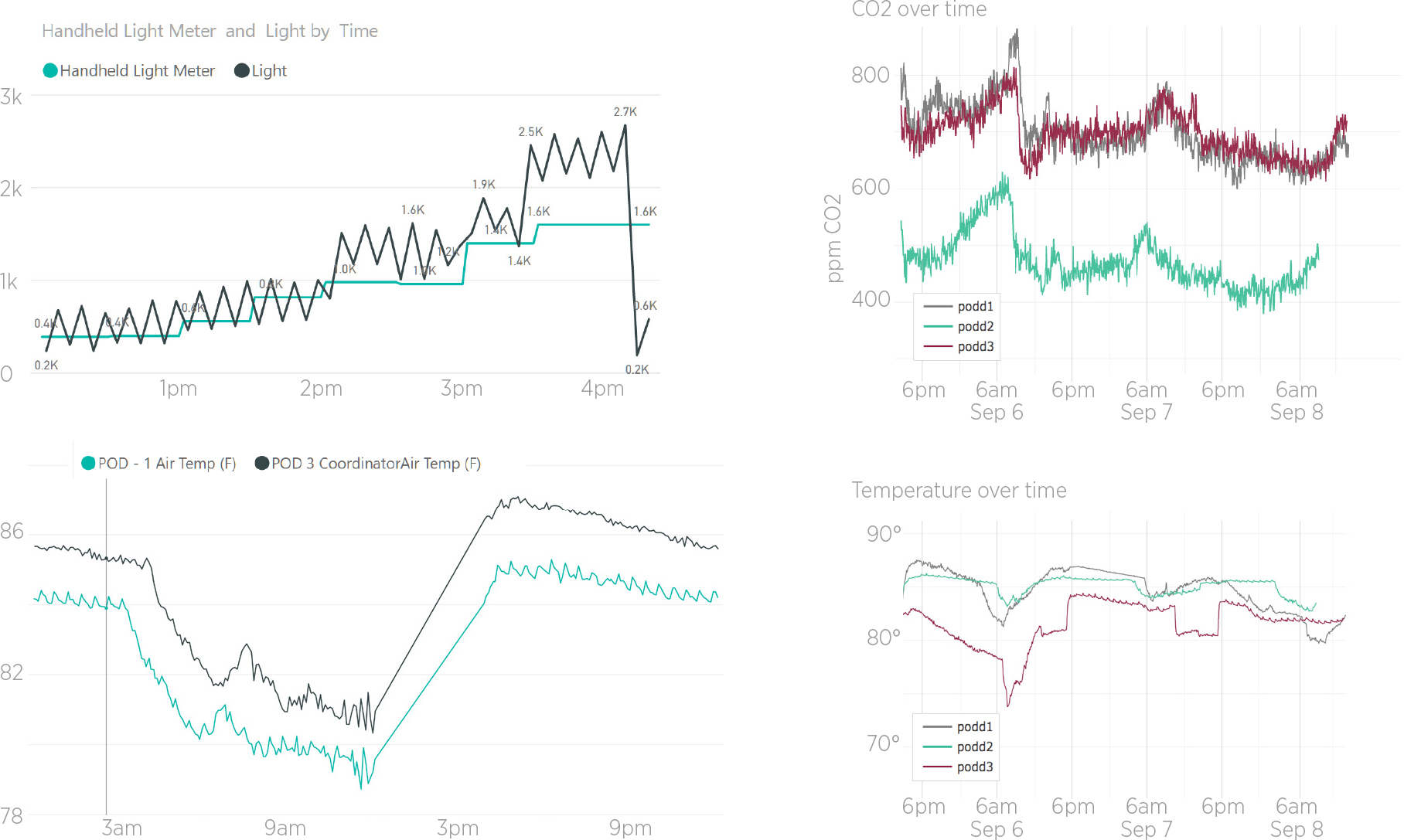
Calibration of units against professional hand held meters and trending data from 3-day test run at one of our naturally ventilated projects (UW Bothell). The data was collected during a hot wildfire season in 2017 and reflects extreme conditions.
Outreach + Advocacy
COMMUNICATING WITH OUR CLIENTS
Our projects comprise our largest direct impact on our environment, and we begin client conversations with our position that a sustainable building is healthy, long-lasting, useful and enjoyable for its occupants, and respectful of our environment. Our discussions include resilience, future climate conditions, occupant comfort, and LMN’s energy, water, and wellness goals and experience.
LMN AND THE SUSTAINABLE DESIGN COMMUNITY
Our sustainable design community is not limited to architects, consultants, engineers and contractors; we engage owners, developers, agencies (building departments, advisory review boards, landmarks boards, and others), occupants who may use a building or public space, those who construct and maintain buildings , neighbors, citizen advocacy groups, and others.
LMN supports staff involvement in shaping policies and resources as part of local, state, and national effort in sustainability topics. Current involvement:
Local
AIA Seattle Public Policy Board
AIA Seattle Board Carbon Leadership Forum
AIA Seattle Committee on the Environment
2030 District Member
International Living Future Institute Sponsor
Healthy Materials Collaborative
Friends of the Waterfront (Seattle)
Central Waterfront Design Oversight Committee
Seattle Design Commission
Bike to Work Month
Seattle Design Festival Board
Seattle 2030 Roundtable
State
AIA Washington Council
Architects and Engineers Legislative Council
Carbon Policy Group
Codes and Standard Group
National
AIA National Energy Leadership Group
Sustainable Design Leaders
Energy Code involvement: local, state, national
Carbon Leadership Forum
IBPSA Sub-Committee on Architectural Simulation
AIA Energy Modeling Design Guide Working Group
United States Green Building Council Member
LMN INVOLVEMENT
- LMNers are active at the state level, through the AIA Washington Council, meeting with legislators, testifying on bills, and striving to influence policy and initiatives to make sustainable design a more integral part of the state’s current and future goals. This includes work on Energy Codes at the National, State, and City levels; advocating for a state Carbon Tax; and other advocacy in the realms of energy, water, mass timber, and materials and health.
- Locally, LMNers are active on the AIA board, as well as city and neighborhood design review boards. These roles are important to give voice and emphasis to short and long-term planning for healthy, vibrant and diverse communities.
- LMNers are active locally in community volunteering, including work with Habitat for Humanity, Duwamish Alive Coalition, Mary’s Place (a local organization that seeks to provide comforting and supportive spaces for at-risk women) and Pasado’s Safe Haven, among numerous others. The firm has encouraged and recognized individual efforts to make our community more healthy, humane and livable for everyone.
- LMN partners with and provides support for local non-profit partners such as Sawhorse Revolution, The Block Project, Mary’s Place, Forterra and numerous others, through onsite workspace, grants, and other advocacy efforts in order to boost their outreach and efficacy. For as much as we give, we learn and are inspired in return.
A full list of involvements is on lmnarchitects.com/about/involvement
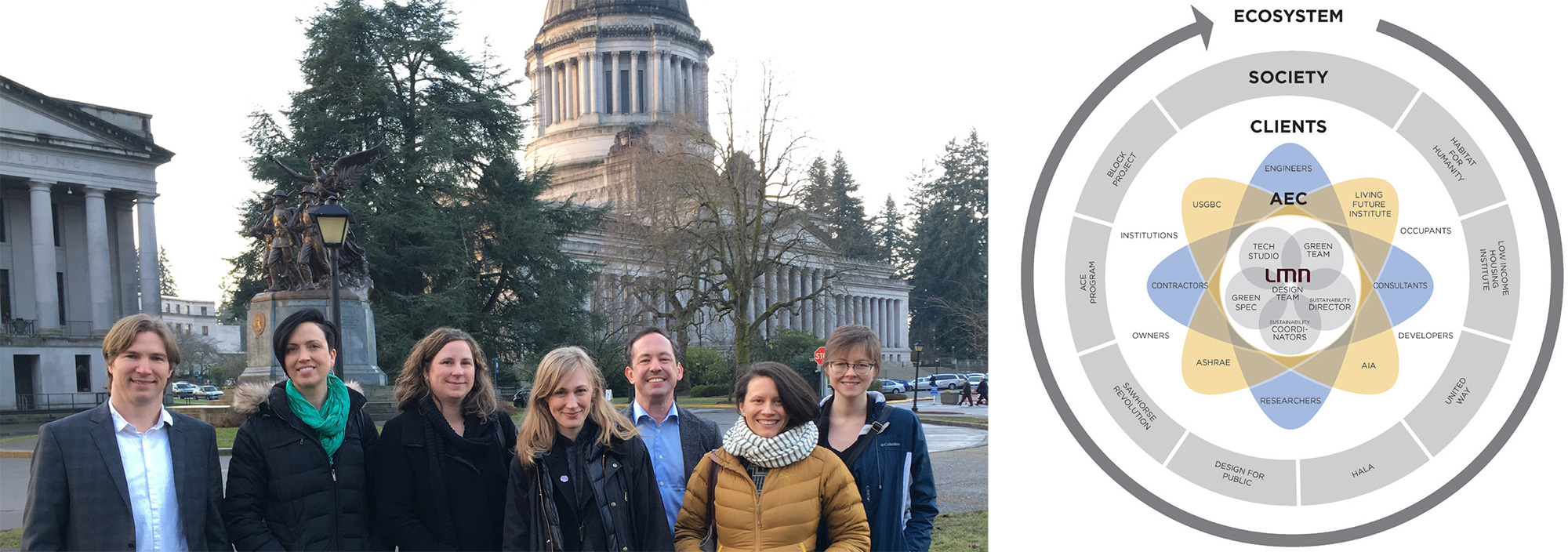
LMN sent several employees to the Washington Capital as part of an AIA effort in 2017 to lobby in support of Mass Timber, Water Issues, and other issues important to our office.
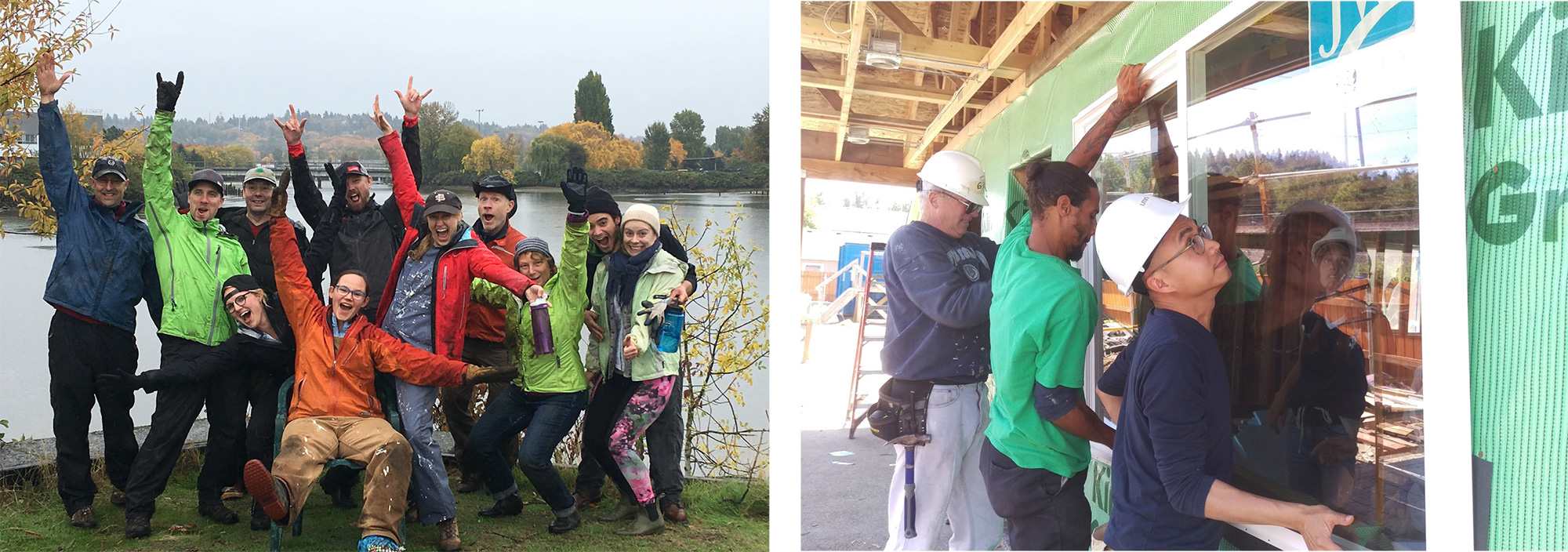
Training + Education
Sustainability is a major component of our Continuing Education program as new methods and research is constantly emerging. LMN encourages all employees to become LEED and/or WELL accredited by subsidizing exam costs, test taking time and study materials. We hold in-house training sessions to increase the 39% of our professional staff that is already LEED accredited. LMN recently had its first few employees receive WELL accreditation, with more to follow.
Every LMN employee is given a $300 stipend and 8-hours of paid time to pursue workshops, conference and seminars outside the office. This is a self-directed program but it is frequently used to attend seminars such as AIA Seattle Resilience Thinking, Passive House Conferences and the NW Greenbuild Slam and Summit.
LMN employees attend and speak at numerous sustainability conferences and workshops including USGBC Greenbuild, Living Future Institute’s Unconference, Mass Timber Conference, the 2030 Commitment Roundtable, AIA+2030 Series, Resilience Thinking Workshop, and Materials Matters, with the expectation of reporting back to the office through intranet posts or Noon Forums. lmnarchitects.com/about/speaking-engagements
The AIA Seattle Material Matters series spurred both an internal Spec Hackathon, to ensure we are taking advantage of every opportunity to make better specifications choices, and an investment in understanding embodied carbon content, and contributing as part of the national Carbon Leadership Forum.
Each year a timely topic is chosen, with internal panels and presentations mixed with outside speakers and activities around the theme: 2018 Year of the Future, 2017 Year of Action!, 2016 Year of Collaboration, 2015 Year of Practice.
Lunch and Learns by product/material vendors are required to complete Mindful Materials disclosure criteria and not include vinyl in our library or presentations. We work as a leading member of the Healthy Materials Collaborative to promote consistency in our transparency ask across firms in Seattle. healthymaterial.org
At the monthly Green Team meeting, Project Sustainability Coordinators share lessons learned and improve our projects directly. Sustainability topics are often on the agenda in LMN’s monthly all-staff Forums as well as at monthly meetings for interest groups: Principals, Project Managers, Project Architects, and Construction Administration.
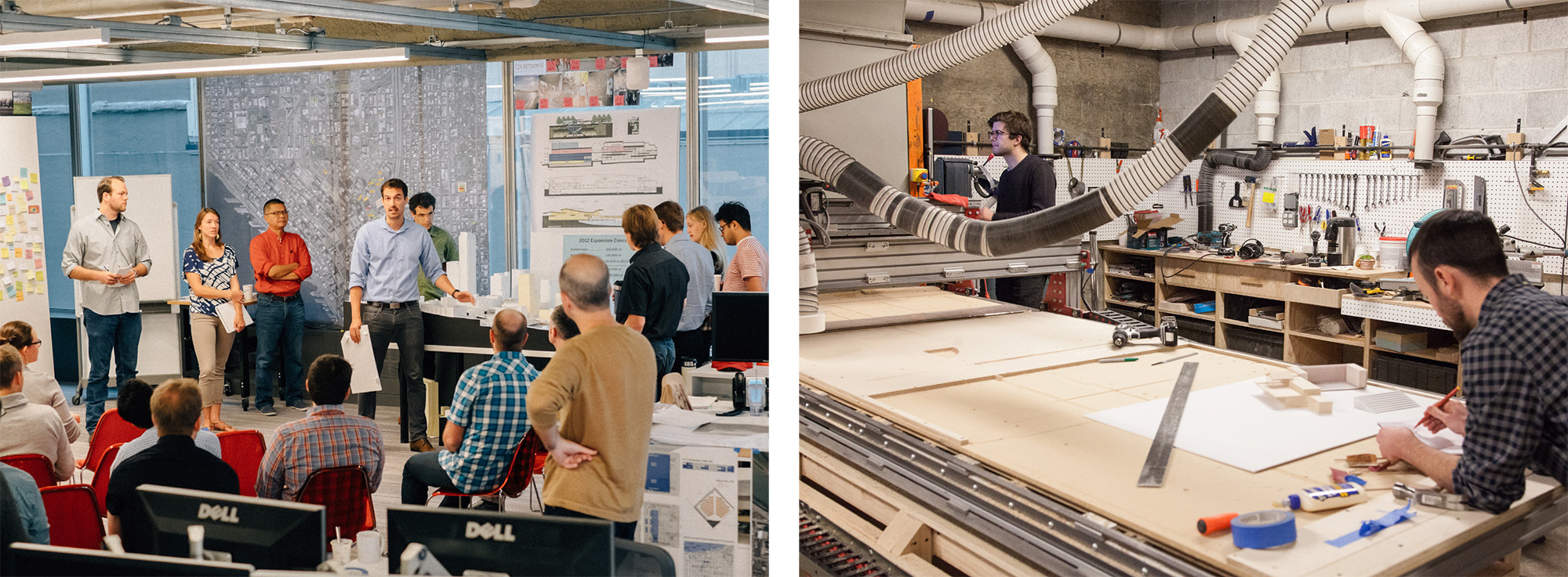
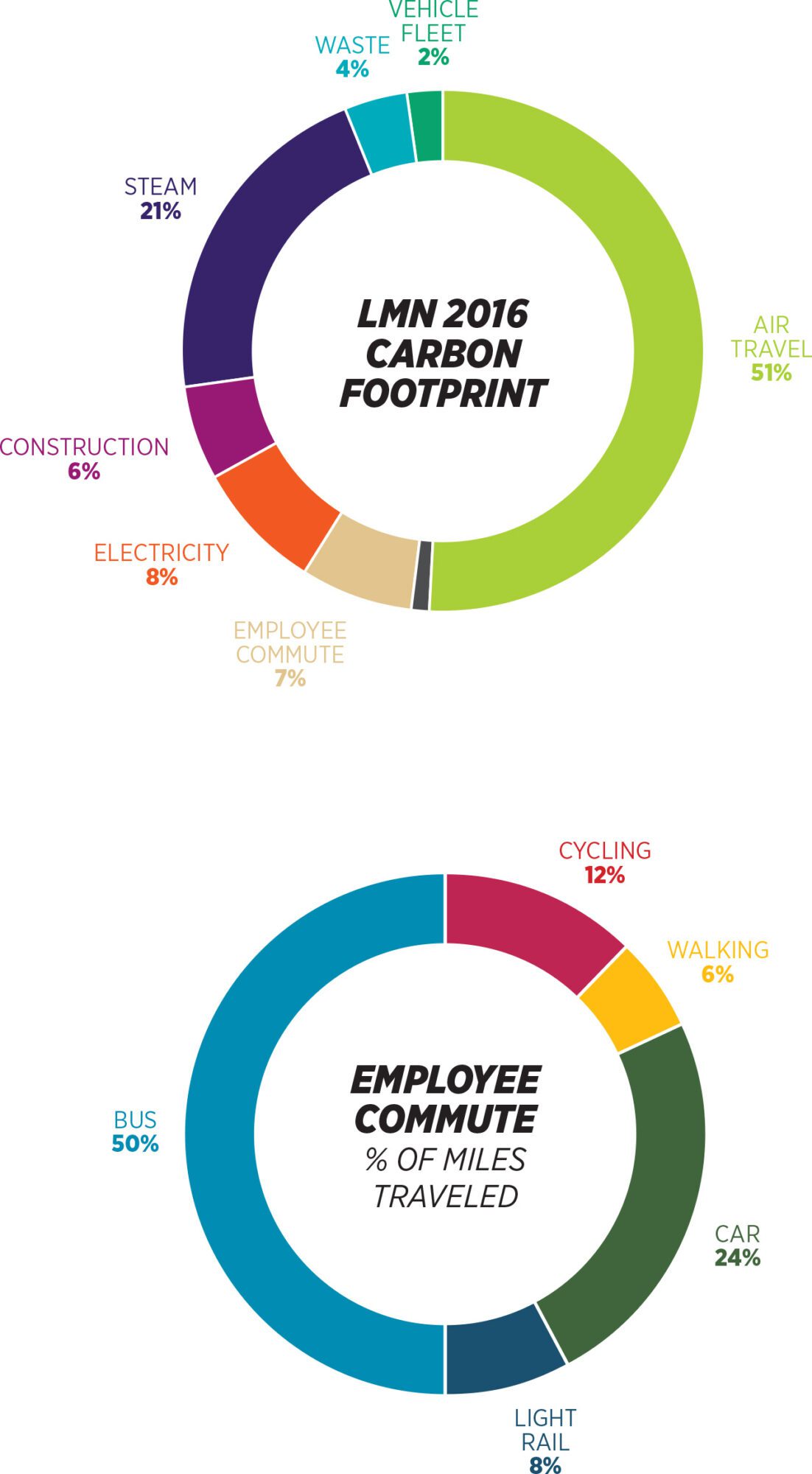
Operations + Maintenance
LMN’s sustainable practice begins in our workplace. Each year we calculate and offset our Co2e emissions from our office, business travel, and commuting. We have reduced office-related emissions per employee by 35% since we began tracking them in 2011, primarily due to reductions in commuting miles, business travel miles, and less office space per employee.
Our renovation, completed in 2014, vetted all materials against the Living Building Challenge Red List. A few materials did not exist as Red List free in 2014, but the renovation gave us an opportunity to review and upgrade our Specs. We also upgraded to 100% LED lighting and automated roller shades.
WASTE, RECYCLE, COMPOST
- We are researching and improving graphics for our discard streams: waste, compost, recycling, and paper recycling to improve our diversion rate.
- We are developing mobile composting stations for lunches in meeting rooms
WELLNESS
- Weekly food deliveries of fresh fruits
- Spray adhesive use is banned in office areas
- Research was conducted into preferable foams for model making: all foam to be white rigid product which was tested to release no measured toxins
- Conducting an in-house office assessment against WELL criteria
- Catering at Meetings
- Criteria for vendors, including food on platters instead of individually wrapped, 25% vegetarian and some gluten-free
- Use non-disposable utensils for lunches < 30 people; all single-use utensils to be compostable
- No bottled water, juice preferred over soda
WORKSTATIONS
- LMN is researching the energy use associated with various workstations and power settings
TRANSPORTATION
- LMN encourages biking to work, providing storage and shower facilities
- Mass transit subsidy, in place since 1998
- Increasing remote meetings to reduce air travel